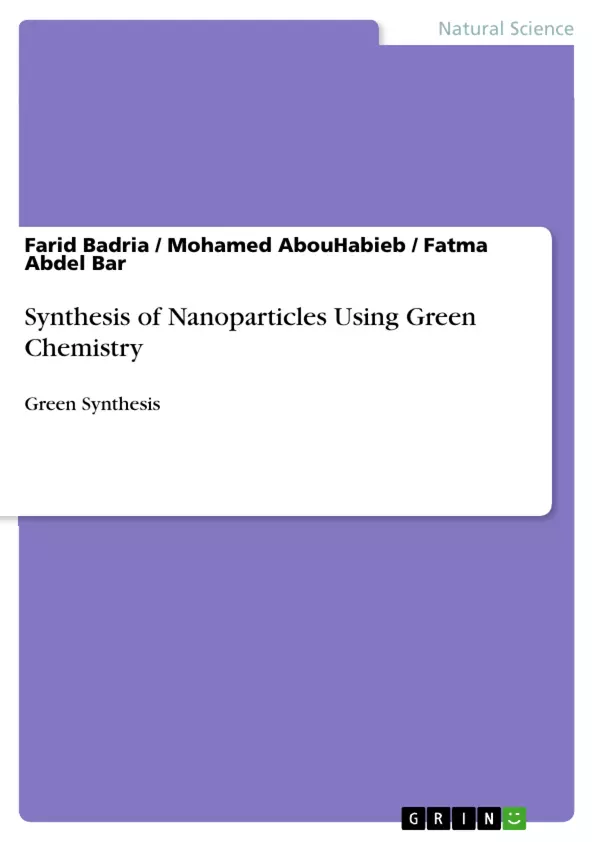Forty-two medicinal plants were collected depending on their availability on Egypt. These plant were extracted and screened for their activity towards green synthesis of AgNPs. A new modified method was used in order to screen large number of extracts in short time (high throughput screening). In this method, the synthesized nanoparticles were evaluated in using 96-well plate which is transparent to facilitate the color monitoring and easy to be read spectrophotometrically using microplate reader. The green synthesis activity by the different plant extracts was monitored and evaluated by color change and UV-Vis absorption at time intervals.
Out of these 42 plants, only 3 plants viz.,Pyllanthusemblicafruits, Psidium guajava leaves and Lawsoniainermisleaves, showed high AgNPs synthetic activity. The most active plant extracts were further partitioned with ethyl acetate. The results showed that the EtOAc fraction of the three active plants showed superior AgNPs green synthesis over their remaining aqueous. Thus, chromatographic columns were used to isolate the active compounds from the EtOAc fraction of each plant.
Metal nanoparticles synthesis is a leading topic of research in modern material science owing to their distinctive potential applications in the field of electronic, optoelectronic, information storage and Health care. Among the all noble metal nanoparticles, silver nanoparticles are one the main products in the field of nanotechnology which has acquired limitless attention due to their unique properties such as chemical stability, good conductivity, catalytic and most important antibacterial, antiviral and antifungal activities. Nevertheless, there is still need for economic commercially viable as well as environmentally clean synthesis route to synthesize the silver nanoparticles.
Table of Contents
- Summary
- Introduction
- Methods
- Chromatographic investigation of the ethyl acetate fraction of emblica:
- Chromatographic investigation of ethyl acetate fraction of Psidium guajava leaves:
- Chromatographic investigation of ethyl acetate fraction of Lawsonia inermis leaves:
- References
Objectives and Key Themes
This study investigates the potential of commonly known Egyptian medicinal plants to synthesize silver nanoparticles from AgNO3 solutions. The study aims to characterize the produced silver nanoparticles using various techniques and evaluate their anticancer and antioxidant properties. Additionally, the study investigates the bioactive molecules present in the most active plant extracts that are responsible for the green synthesis activity.
- Green synthesis of silver nanoparticles using plant extracts
- Characterization of silver nanoparticles
- Evaluation of anticancer activity of silver nanoparticles
- Evaluation of antioxidant activity of silver nanoparticles
- Identification and characterization of bioactive molecules in the most active plant extracts
Chapter Summaries
Chapter 1: Chromatographic investigation of the ethyl acetate fraction of emblica:
The ethyl acetate fraction of Phyllanthus emblica fruits was chromatographically separated using silica gel column chromatography and further purified with Sephadex LH-20 column chromatography to isolate five compounds. These compounds were identified as trans-cinnamic acid, methyl gallate, gallic acid, emblifatmin (a new compound), and quercetin-3-O-α-arabinofuranoside (avicularin).
Chapter 2: Chromatographic investigation of ethyl acetate fraction of Psidium guajava leaves:
The ethyl acetate fraction of Psidium guajava leaves was separated and purified using similar chromatographic techniques as in Chapter 1. This led to the isolation and identification of five compounds, including pyrogallol, quercetin, quercetin-3-O-β-D-xylopyranoside (reynoutrin), quercetin-3-O-β-arabinopyranoside (a new compound), and quercetin-3-O-α-L-arabinofuranoside (avicularin).
Chapter 3: Chromatographic investigation of ethyl acetate fraction of Lawsonia inermis leaves:
This chapter focuses on the chromatographic separation and purification of the ethyl acetate fraction of Lawsonia inermis leaves. The investigation identified three compounds, namely p-coumaric acid, lawsone, and luteolin.
Keywords
The study focuses on the green synthesis of silver nanoparticles using plant extracts, particularly from Egyptian medicinal plants. Key themes include the characterization of the synthesized nanoparticles, their anticancer and antioxidant properties, and the identification of bioactive molecules responsible for the green synthesis activity. Important concepts include plant-mediated synthesis, surface plasmon resonance, FTIR spectroscopy, TEM analysis, cytotoxicity, antioxidant activity, and the structure-activity relationships of bioactive compounds.
- Citation du texte
- Farid Badria (Auteur), Mohamed AbouHabieb (Auteur), Fatma Abdel Bar (Auteur), 2017, Synthesis of Nanoparticles Using Green Chemistry, Munich, GRIN Verlag, https://www.grin.com/document/509334



